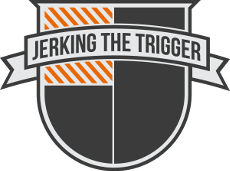As much as I liked the Crimson Trace (CT) LG-417 for the Glock, I think I may actually like the LG-405 for Smith & Wesson J-Frame Revolvers even more. These CT LaserGrips greatly enhance the capabilities of a classic CCW.
Overview
The LG-405 is a compact grip for a compact handgun. It is relatively slim and only as long as the J-Frame grip tang. The grip is comprised of cushioning rubber on the upper back and front strap with hard plastic panels on the sides. The laser module is located at the top of the grip panel on the opposite side as the cylinder latch. There is a very small switch at the base of the grip that can disable the laser.
The grip has all of the ergonomic features that I like to see in a J-Frame grip. It completely covers the front strap of the grip tang so it is hand filling. It fills in behind the trigger guard to keep it from beating the tar out of your knuckle, it keeps the base of the grip tang clear for easier concealment, and the cylinder latch side of the grip is aggressively recessed to allow the use of speed-loaders.
Observations from Use
The LG-405 would be a great J-Frame grip even without the laser. This is subjective but it does everything I like a J-Frame grip to do. It has ergonomic features that take the edge off the sharp recoil that is typical of these handguns, it is textured enough to lock it into the hand during recoil, it stays out of the way of even with the most finicky speed-loaders (Safariland, which also happens to be my favorite), and it does this all while remaining very compact.
If you want to improve your double action trigger pull, get a laser, head to the range, and prepare to be humbled as you watch the laser dot dance, dart, and dive all over the target as you learn to control the trigger throughout the long and heavy double action trigger pull. It can be hard to master, but being able to see how your trigger pull is affecting your point of aim in real time on the target is the type of feedback that can help accelerate your learning.
J-Frame revolvers have one main issue that holds them back in low light scenarios – you can’t see the sights. The sights on most J-Frames consist of a short ramp front and a shallow notch rear that are not easily replaceable. They are hard to use in full daylight, let alone in low light. The addition of CT LaserGrips makes the J-Frame far more useable in low light, even when used with a flashlight. In drills, my hit probability and hit quality both when up while the time it took to take these shots went down. The LaserGrips provide a measurable improvement in the low light capabilities of the venerable, old J-Frame.
The same issues with the sights mentioned above, also make it difficult to use the J-Frame at extended handgun distances (beyond 15 yards). The difficult-to-master double action trigger doesn’t help either. However, the LaserGrips improve both issues. They provide an easier method of aiming and give real time feedback about what your trigger pull is doing to your point of aim. They give the confidence necessary to utilize the J-Frame at 25 yards and further.
The grips must be removed in order to change the batteries (2x 2032 coin cells). I co-witnessed the laser to the iron sights, then removed and reinstalled the grips to test whether the laser held zero after removal. It seemed to or at least it was close enough for my purposes. If you do have to re-zero, it is pretty easy to do. You can simply co-witness to the iron sights at your desired distance and then refine at the range if you like. I find that co-witnessing alone is good enough for my purposes.
Wrap Up
The LG-405 LaserGrips make J-Frames easier to use effectively in low light and at extended distances, effectively removing two limitations of the J-Frame revolver. If you carry a J-Frame, it should be wearing a set of LaserGrips. I am convinced of that.
Check out the LG-405 LaserGrips on CrimsonTrace.com.

























